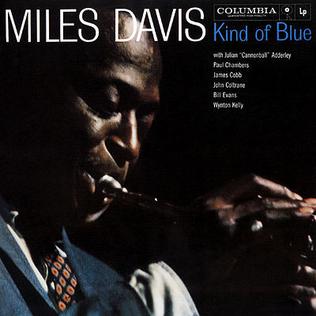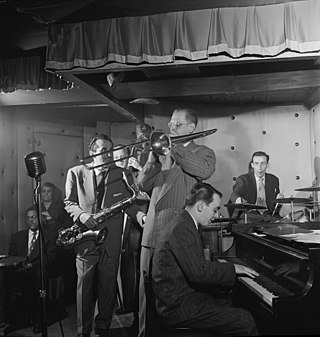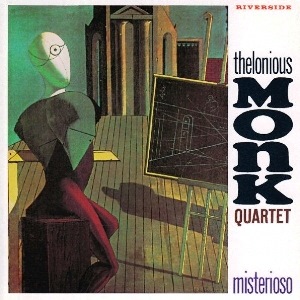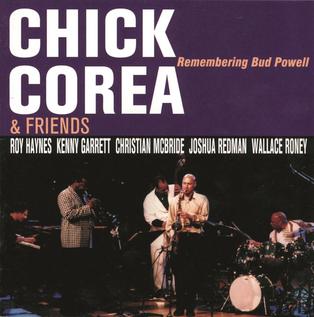Related Research Articles

Bebop or bop is a style of jazz developed in the early-to-mid-1940s in the United States. The style features compositions characterized by a fast tempo, complex chord progressions with rapid chord changes and numerous changes of key, instrumental virtuosity, and improvisation based on a combination of harmonic structure, the use of scales and occasional references to the melody.
Modal jazz is jazz that makes use of musical modes, often modulating among them to accompany the chords instead of relying on one tonal center used across the piece. Although precedents exist, modal jazz was crystallized as a theory by composer George Russell in his 1953 book Lydian Chromatic Concept of Tonal Organization.

Earl Rudolph "Bud" Powell was an American jazz pianist and composer. A pioneer in the development of bebop, jazz critics have commented that his compositions and playing style "greatly extended the range of jazz harmony," and his application of complex bebop phrasing to the piano influenced both his contemporaries and later pianists including Walter Davis, Jr., Toshiko Akiyoshi, and Barry Harris.

Kind of Blue is the fifth studio album released on Columbia, and twenty-eighth overall, by the American jazz musician, trumpeter, composer, and bandleader Miles Davis. It was recorded on March 2 and April 22, 1959, at Columbia's 30th Street Studio in New York City, and released on August 17 of that same year by Columbia Records. For the recording, Davis led a sextet featuring saxophonists John Coltrane and Julian "Cannonball" Adderley, pianist Bill Evans, bassist Paul Chambers, and drummer Jimmy Cobb, with new band pianist Wynton Kelly appearing on one track – "Freddie Freeloader" – in place of Evans.

Hard bop is a subgenre of jazz that is an extension of bebop music. Journalists and record companies began using the term in the mid-1950s to describe a new current within jazz that incorporated influences from rhythm and blues, gospel music, and blues, especially in saxophone and piano playing.

Clifford Benjamin Brown was an American jazz trumpeter. pianist and composer. He died at the age of 25 in a car crash, leaving behind four years' worth of recordings. His compositions "Sandu", "Joy Spring", and "Daahoud" have become jazz standards. Brown won the DownBeat magazine Critics' Poll for New Star of the Year in 1954; he was inducted into the DownBeat Hall of Fame in 1972.

Theodore "Fats" Navarro was an American jazz trumpet player and a pioneer of the bebop style of jazz improvisation in the 1940s. A native of Key West, Florida, he toured with big bands before achieving fame as a bebop trumpeter in New York. Following a series of studio sessions with leading bebop figures including Tadd Dameron, Bud Powell, and Kenny Clarke, he became ill with tuberculosis and died at the age of 26. Despite the short duration of his career, he had a strong stylistic influence on trumpet players who rose to fame in later decades, including Clifford Brown and Lee Morgan.

"Un Poco Loco" is an Afro-Cuban jazz standard composed by American jazz pianist Bud Powell. It was first recorded for Blue Note Records by Powell, Curly Russell, and Max Roach on May 1, 1951.

St. Elmo Sylvester Hope was an American jazz pianist, composer, and arranger, chiefly in the bebop and hard bop genres. He grew up playing and listening to jazz and classical music with Bud Powell, and both were close friends of another influential pianist, Thelonious Monk.

George Allen Russell was an American jazz pianist, composer, arranger and theorist. He is considered one of the first jazz musicians to contribute to general music theory with a theory of harmony based on jazz rather than European music, in his book Lydian Chromatic Concept of Tonal Organization (1953).

George Wallington was an American jazz pianist and composer. Born in Sicily, his career as a pianist began in the early 1940s, when he played with Dizzy Gillespie and Charlie Parker and contributed to the development of bebop. Following several years as a sideman during the late 1940s, he formed his own group, experimenting with trios and a string ensemble before settling upon a permanent quintet.
"Hot House" is a bebop standard, composed by American jazz musician Tadd Dameron in 1945. Its harmonic structure is identical to Cole Porter's "What Is This Thing Called Love?". The tune was made famous by Dizzy Gillespie and Charlie Parker as a quintet arrangement and become synonymous with those musicians; "Hot House" became an anthem of the bebop movement in American jazz. The most famous and referred to recording of the tune is by Parker and Gillespie on the May 1953 live concert recording entitled Jazz at Massey Hall, after previously recording it for Savoy records in 1945 and at Carnegie Hall in 1947. The tune continues to be a favorite among jazz musicians and enthusiasts:

Miles Smiles is an album by jazz musician Miles Davis, released on February 16, 1967 on Columbia Records. It was recorded by Davis and his second quintet at Columbia 30th Street Studio in New York City on October 24 and October 25, 1966. It is the second of six albums recorded by Davis' second great quintet, which featured tenor saxophonist Wayne Shorter, pianist Herbie Hancock, bassist Ron Carter, and drummer Tony Williams.

Porgy and Bess is a studio album by jazz musician Miles Davis, released in March 1959 on Columbia Records. The album features arrangements by Davis and collaborator Gil Evans from George Gershwin's 1935 opera of the same name. The album was recorded in four sessions on July 22, July 29, August 4, and August 18, 1958, at Columbia's 30th Street Studio in New York City. It is the second collaboration between Davis and Evans and has garnered much critical acclaim since its release, being acknowledged by some music critics as the best of their collaborations. Jazz critics have regarded the album as historically important.

Dillon "Curley" Russell was an American jazz musician, who played bass on many bebop recordings.

Misterioso is a 1958 live album by American jazz ensemble the Thelonious Monk Quartet. By the time of its recording, the pianist and bandleader Thelonious Monk had overcome an extended period of career difficulties and achieved stardom with his residency at New York's Five Spot Café, beginning in 1957. He returned there the following year for a second stint with his quartet, featuring drummer Roy Haynes, bassist Ahmed Abdul-Malik, and tenor saxophonist Johnny Griffin. Along with Thelonious in Action (1958), Misterioso captures portions of the ensemble's August 7 show at the venue.
"Ko-Ko" is a 1945 bebop recording composed by Charlie Parker. The original recorded version lists Parker on alto saxophone with trumpeter Miles Davis, double bassist Curley Russell and drummer Max Roach. Due to the absence of Bud Powell, Dizzy Gillespie was enlisted to play piano, instead of his usual trumpet. Pianist Sadik Hakim, then known as Argonne Thornton, was also known to be present at the session. Rumors persist to this day about precisely who played trumpet and piano on this piece; some claim it's young Miles Davis who plays trumpet and Gillespie comping at piano, on both takes; most claim Gillespie plays trumpet and, or instead of, piano; some claim Hakim is the pianist on all or part of one or both of the takes. However, Miles Davis confirms in his autobiography that he did not play trumpet on "Ko Ko":
"I remember Bird wanting me to play "Ko-Ko," a tune that was based on the changes of "Cherokee." Now Bird knew I was having trouble playing "Cherokee" back then. So when he said that that was the tune he wanted me to play, I just said no, I wasn't going to do it. That's why Dizzy's playing trumpet on "Ko-Ko," "Warmin' up a Riff," and "Meandering" on Charlie Parker’s Reboppers, because I wasn't going to get out there and embarrass myself. I didn't really think I was ready to play tunes at the tempo of "Cherokee" and I didn't make no bones about it."

1958 Miles is a compilation album by American jazz musician Miles Davis, released in 1974 on CBS/Sony. Recording sessions for tracks that appear on the album took place on May 26, 1958, at Columbia's 30th Street Studio and September 9, 1958, at the Plaza Hotel in New York City. 1958 Miles consists of three songs featured on side two of the LP album Jazz Track, which was released in November 1959, one song from the same session not appearing in the album, and three recordings from Davis' live performance at the Plaza Hotel with his ensemble sextet. The recording date at 30th Street Studio served as the first documented session to feature pianist Bill Evans performing in Davis' group.
"Conception" is a 1950 jazz standard written by George Shearing in the bebop style. The composition is in the key of Db and is noticeable for its chromatic descending chord sequences. The original score was adapted by Miles Davis in 1950, who created an arrangement that kept Shearing's chord changes and main theme, but replaced the composition's bridge and ending with new melodic material. This arrangement is documented on a February 1950 broadcast recording in New York City featuring Stan Getz, J.J. Johnson, and Art Blakey. Davis recorded this same arrangement in October 1951 for his first LP, The New Sounds. Davis also did a complete rewrite of 'Conception' in 1950 for his Birth of the Cool nonet, giving the composition the title 'Deception'. 'Deception', recorded in March 1950, retained the rewritten bridge melody from Davis' 1950 'Conception' arrangement, as well as Shearing's original chord progression. Davis's 1954 Blue Note recording "Take Off" also uses the "Conception" chord progression, including Davis' own additions to the form, but "Take Off" does not include any of Shearing's original melody, and is credited to Davis.

Remembering Bud Powell is an album by pianist Chick Corea and Friends performing tunes by Bud Powell. It was released on Corea's Stretch label in 1997.
References
- ↑ Groves, Alan; Shipton, Alyn (1993). Glass Enclosure: The Life of Bud Powell. Bloomsbury. p. 127. ISBN 978-1871478266. LCCN 2001028002.
- 1 2 3 4 5 6 7 8 Davis, Francis (January 1996). "Bud's Bubble: The pianist Bud Powell was mad even by bebop's standards" . The Atlantic . Vol. 277, no. 1. pp. 99–102. Archived from the original on August 14, 2020.
- ↑ Gross, Terry (March 24, 2014). "After a Painful Year, Bud Powell's Triumphant 1953 Return". Fresh Air (transcript). NPR. Archived from the original on December 21, 2020.
- 1 2 3 4 Mathieson, Kenny (2012) [1999]. Giant Steps: Bebop and the Creators of Modern Jazz, 1945-65. Canongate. ISBN 978-0862418595.
- ↑ Hentoff, Nat (November 27, 1954). "Bud Powell". DownBeat . Vol. 21, no. 23. p. 13.
- ↑ "Bud Powell – Birdland 1953". ESP-Disk. Retrieved September 1, 2014.
- ↑ Shanley, Mike (July 3, 2014). "Bud Powell: Birdland 1953" . JazzTimes .
- ↑ "Crossing the Channel". dothemath. Retrieved September 1, 2014.
- ↑ Mercer, Michelle (2004). Footprints: The Life and Work of Wayne Shorter. Penguin. ISBN 978-1585423538. LCCN 2004058845.
- ↑ DeMotta, David J. (2015) The contributions of Earl "Bud" Powell to the modern jazz style. Doctoral dissertation, The City University of New York.